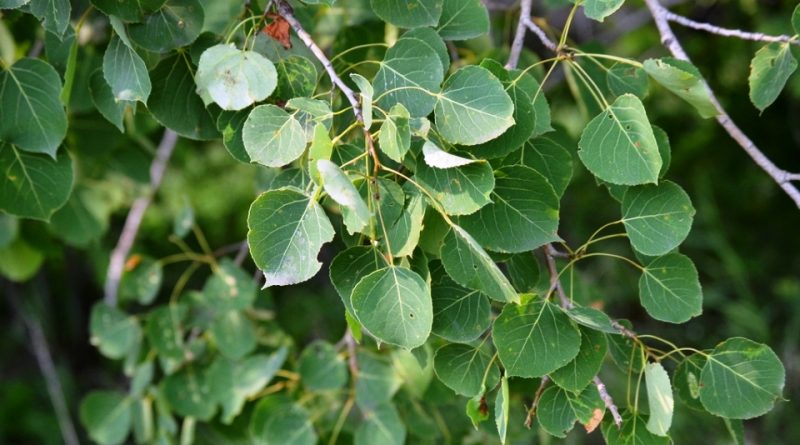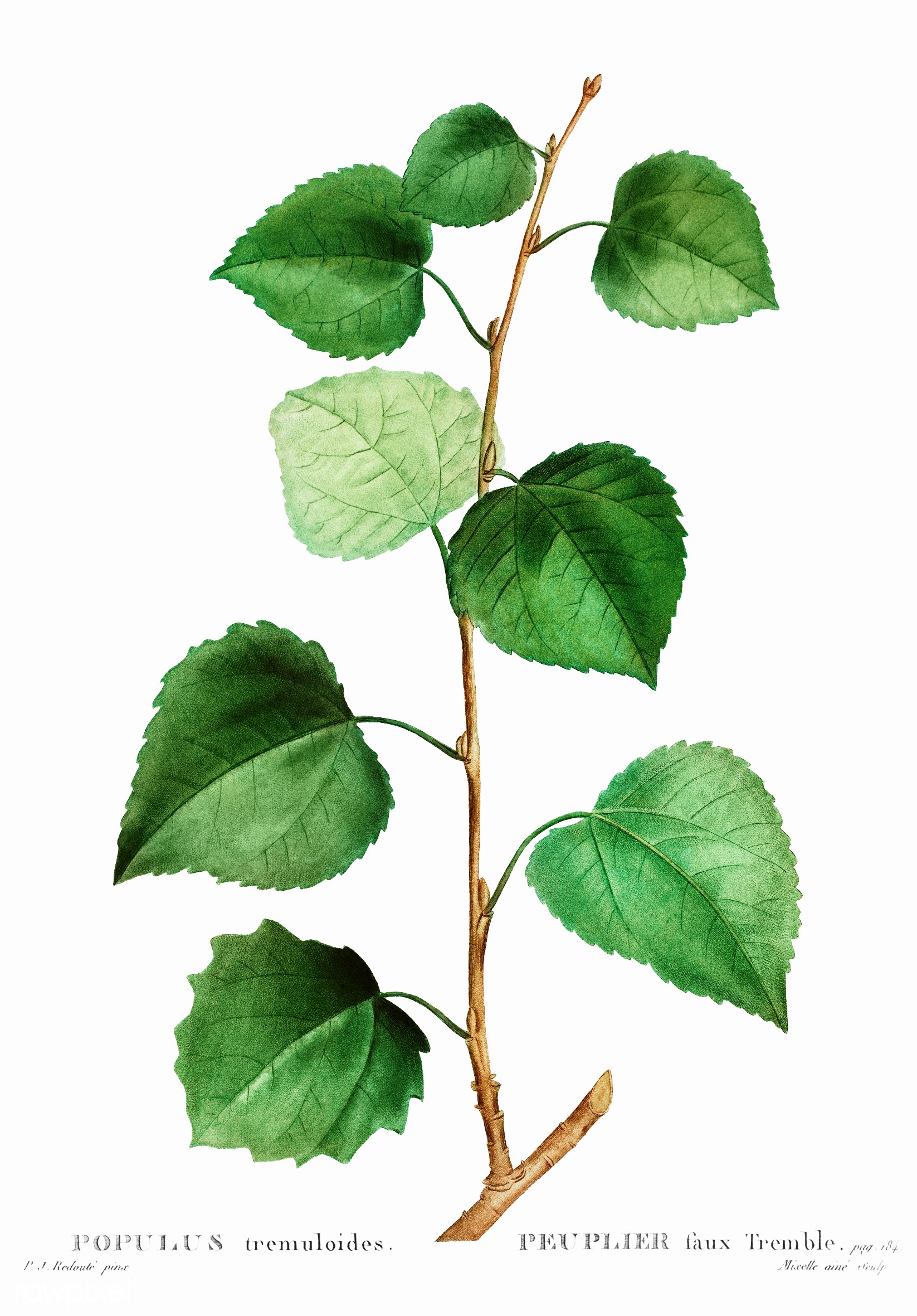Populus tremuloides
Populus tremuloides
The quaking aspen or trembling aspen or American aspen and other names (Populus tremuloides Michx., 1753) is an arboreal sepcie belonging to the Salicaceae family.
Systematics –
From a systematic point of view it belongs to:
Eukaryota Domain,
Kingdom Plantae,
Magnoliophyta Division,
Magnoliopsida class,
Order Salicales,
Salicaceae family,
Genus Populus,
P. tremuloides species.
The following terms are synonymous:
– Populus atheniensis Lodd .;
– Populus atheniensis Lodd. ex Tax Code Ludw .;
– Populus aurea Tidestr .;
– Populus benzoifera Tausch;
– Populus cercidiphylla Britton;
– Populus cordata hort .;
– Populus cordata hort. ex Poir .;
– Populus glandulosa Willd .;
– Populus glandulosa Willd. ex Steud .;
– Populus graeca Aiton;
– Populus hispida Hausskn. & Sint .;
– Populus pendula hort. formerly Tausch;
– Populus sibirica hort .;
– Populus sibirica hort. formerly Tausch;
– Populus tremula subsp. tremuloides (Michx.) Á. & D.Löve;
– Populus tremuliformis Emers .;
– Populus tremuloides Tidestr .;
– Populus tremuloides f. betuloides J. Rousseau;
– Populus tremuloides f. lesser Cockerell;
– Populus tremuloides f. dwarf Cockerell;
– Populus tremuloides f. pendula (Tausch) Schelle;
– Populus tremuloides f. tremuloides;
– Populus tremuloides var. aurea (Tidestr.) Daniels;
– Populus tremuloides var. cercidiphylla (Britton) Sudw .;
– Populus tremuloides var. davisiana Tidestr .;
– Populus tremuloides var. intermediate Vict .;
– Populus tremuloides var. magnificent Vict .;
– Populus tremuloides var. rhomboidea Vict .;
– Populus tremuloides var. tremuloides;
– Populus tremuloides var. vancouveriana (Trel.) Sarg .;
– Populus trepida Willd .;
– Populus vancouveriana Trel .;
– Populus vancouveriana Trel. ex Tidestr .;
– Populus × polygonifolia F.G.Bernard;
– Tremula trepida Raf ..
Etymology –
The term Populus comes from the Greek πάλλω pállo jump, shake, tremble: due to the behavior of the branches under the action of the wind.
The specific epithet tremuloides comes from the Latin tremulus ‘tremulo’ as it resembles the aspen.
Geographic Distribution and Habitat –
Populus tremuloides is a deciduous tree native to the cooler areas of North America.
This plant is present in all provinces and territories of Canada, with the possible exception of Nunavut. In the United States, it can be found as far north as the northern slopes of the Brooks Range in Alaska, where road edges and gravel blocks provide islands of well-drained habitat in a region where soils are often waterlogged due to the permafrost below.
Its habitat is that of areas at low altitudes up to the extreme south of northern Nebraska and central Indiana. In the western United States, this tree rarely survives at altitudes below 460m due to the hot summers present below that altitude, and is generally found at 1,500-3,700m.
It is the only deciduous angiosperm to extend over the vast range between the Atlantic and the Pacific.
Description –
Populus tremuloides is a tall, fast-growing tree, usually 20-25m when mature, with a trunk 20 to 80cm in diameter.
The bark is relatively smooth, greenish white to gray in color, and is characterized by thick black horizontal scars and prominent black knots. Parallel vertical scars are telltale signs of moose, ripping off the poplar’s bark with their front teeth.
The leaves on mature trees are nearly round, 4-8 centimeters in diameter with small rounded teeth and 3-7 centimeters horizontally.
Young trees and root sprouts have much larger (10-20cm and 4-8cm long) nearly triangular leaves.
The leaves are glossy green, dull underneath and turn gold to yellow, rarely red, in the fall.
It is a dioecious plant with separate male and female flowers.
The flowers are 4-6 cm long catkins, produced in early spring before the leaves.
The fruit is The fruit is a string of pendulous capsules, 10 centimeters long, made up of several 6 millimeters capsules; each capsule containing about ten small seeds embedded in a cottony down, which helps their dispersion as they mature in early summer.
2-3 year old trees can start producing seeds, but significant production starts at 10 years of age. The best seed production is obtained between 50 and 70 years.
Cultivation –
Populus tremuloides is a plant that grows in a wide variety of climatic conditions. Average temperatures in January and July range from -30 ° C and 16 ° C in the interior of Alaska to -3 ° C and 23 ° C in Fort Wayne, Indiana.
Average annual rainfall ranges from 1,020mm in Gander, Newfoundland and Labrador up to 180mm in interior Alaska. The southern limit of the species range follows approximately the average July isotherm of 24 ° C.
This plant often propagates through its roots to form large clonal thickets originating from a shared root system. These roots are not rhizomes, as the new shoots, which form the new plants, develop from adventitious buds generated by the parent root system.
Poplars produce seeds, but plants are rarely generated from them. Pollination is inhibited by the fact that poplars are male or female, and large populations are generally all clones of the same sex. Although pollinated, the tiny seeds are only viable for a short time as they lack a stored food source or protective coating.
Customs and Traditions –
Populus tremuloides buds and bark provide food for hares, elk, black bear, wild rabbit, porcupine, deer, grouse, and mountain beaver. The sprouts are eaten by sheep, goats and cattle. Elk is also known to graze trees. In addition, the leaves of this plant and other species of the genus Populus serve as food for the caterpillars of various moths and butterflies.
Poplar bark contains a substance that has been extracted by indigenous North Americans and European settlers in the western United States as a substitute for quinine.
The bark of this plant has been used for various medicinal uses. It has been used in diseases of the bladder, urethra and prostate and for other uses in native folk medicine.
Among other uses it should be remembered that in Canada, wood of this species is mainly used for cellulose products such as books, newsprint and fine printing paper. It is particularly useful for panel products such as oriented stranded panels and other artifacts.
Although poplars produce poor wood, as they dry slowly, rot quickly, and don’t give off much heat, they are still widely used on camping sites because they are cheap, abundant, and not widely used in construction lumber.
From an ecological point of view, however, it is necessary to highlight how, starting from the 1990s, North American scientists have noticed an increase in dead or dying poplar trees. No insect, disease or environmental condition has been found or identified as a cause.
Many areas of the western United States have experienced increased dieback that is often attributed to ungulate grazing and fire suppression. At high altitudes, where grasses can be rare, ungulates can nibble on young aspen shoots and prevent those young trees from reaching maturity. As a result, some poplars near pastures for cattle or other animals, such as deer or moose, have very few young trees and may be overrun with conifers, which are typically not grazed. Another possible deterrent to Populus tremuloides regeneration is widespread suppression of forest fires. Poplars are vigorous breeders and although the aboveground part of the organism can die in a fire, the roots, which are often protected from lethal temperatures during a fire, sprout producing new trees soon after a fire. Disturbances such as fires appear to be an ecological event necessary for aspen to compete with conifers, which tend to replace aspen over long, unhindered intervals. The current wasting in the American West may have roots in the strict fire suppression policy in the United States.
To these factors can be added the proliferation of some beetles that could change the vegetational relations between this poplar and some conifers and the proliferation of clonal populations that could lead to even lethal decay of the entire population.
Preparation Method –
Of the quaking aspen, like other poplars, the bark, leaves and buds are used especially for healing purposes.
The use and methods also depend on the traditions of the natives of North America and on the traditions handed down.
Photo source: https://www.inaturalist.org/guide_taxa/1171421
Guido Bissanti
Sources
– Acta Plantarum – Flora of the Italian Regions.
– Wikipedia, the free encyclopedia.
– Useful Tropical Plants Database.
– Conti F., Abbate G., Alessandrini A., Blasi C. (ed.), 2005. An annotated checklist of the Italian vascular flora, Palombi Editore.
– Pignatti S., 1982. Flora of Italy, Edagricole, Bologna.
– Treben M., 2000. Health from the Lord’s Pharmacy, Advice and experiences with medicinal herbs, Ennsthaler Editore.
Warning: Pharmaceutical applications and alimurgical uses are indicated for informational purposes only, they do not represent in any way a medical prescription; therefore no responsibility is taken for their use for curative, aesthetic or food purposes.


